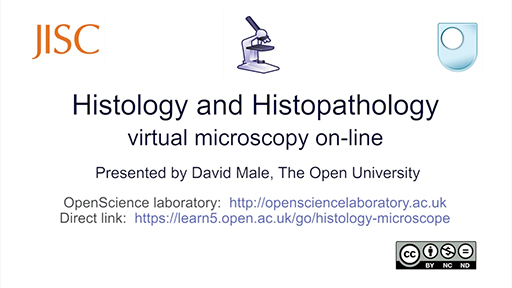1.6 How the virtual microscope images were produced
In this video, David Male discusses The Open University’s virtual microscope project.
Download this video clip.Video player: 39891_ou_futurelearn_mc1008_vid_010-540.mp4


Transcript
DAVID MALE
The digital microscope is a virtual representation of a real microscope, this microscope here. And we have a large collection of slides, which we've collected from various pathology departments and hospitals and histology units all around the country, specialists units. And then they have given us the opportunity to create very large images. It's very, very like Google Earth type of images, very big scans, which we can effectively zoom across and scan into, which recreates what is going on in a real microscope here.
And we have a collection of around about 300 slides that we've obtained in this way. And we make them starting from a unit, a little section like this which goes onto the microscope. And then there's a sort of fairly complicated set up. It's a high-end microscope. It costs about 50,000 or 60,000 pounds. But it does give students the opportunity to look at material that they would not otherwise be able to see from specialist units and also on the kind of microscope that they would never, ever be able to get their hands on.
Initially, we designed the resource for undergraduate students and particularly sort of first and second year of their studies. They would be medical students or zoology students, this kind of person. It's also for training hospital laboratory technicians. And we're starting to put in an a-level teaching set as well at the moment, which is, obviously, a little simpler, but also includes some plant materials to go with it.
At the other end, we have very specialist sets of pathology slides. So, for example, there's a set from the Institute of Ophthalmology, a set of eye slides, very particular kind of diseases there. And this kind of material would be suitable for really up to a hospital consultant level.
We have a series of 20 units, which are listed here in the catalogues. So for example, you'll see that one of the sets is a set of skin slides. And if I pull that up by clicking on it like that, you'll see that there's something like 15 or 16 slides in there of different skin pathologies.
When you want to look at one of these slides, you just load it up by clicking on it. And this loads it onto the microscope stage here. And then we get a larger view of it over here. And the digital microscope allows us to move around so we can scan across the slide like this. We can zoom in by changing, effectively, the objective that we're using here. And you can see now we've got a larger image of it on the screen there.
We can do a whole number of things like add grids onto it or graticules. We can change the focus of it. It emulates the workings of a real microscope in changing the focus and also the lighting of the slide.
And the most useful thing of all are these legends here. So for example, if we click on this one, which says we're going to a sweat gland, an eccrine sweat gland, then the microscope will immediately jump to that particular position. So that it effectively replaces the function of a tutor that you might have looking over your shoulder at what you're looking at down a real microscope.
You can go to a particular area on the slide by typing in its coordinates. And when you press go, it will immediately jump to a particular area, and then you can ask the student what they are seeing at that particular point on the slide.
We also have a camera button. And so, for example, a student could take a picture of what they're seeing and what magnification they're using and insert this little piece of picture into an assignment of some sort, say, some description of a pathology or whatever. And then that can be used as part of an assessment.
As we started to talk to people we found people coming to us with their own specialist collections and saying, actually we've got an excellent set of liver slides or an excellent set of kidney slides. And we'd really like to include this material. So we are open to working with various partners partly to expand the collection and improve it, but also to help create teaching material that they can work with and will be useful for them.
TEXT ON SCREEN
The slide collection includes 320 sections with a set of normal tissues and 12 collections based on tissue type and pathology. Slides and images were provied by De Montfort University, UCLH London, The Institute of Opthamology, Cambridge University, Milton Keynes NHS Trust, Leicester General Infirmary, KCL London. The microscope was developed by a team at The Open University, directed by Professor David Male and it was funded by a project grant from JISC.
Interactive feature not available in single page view (see it in standard view).
As the collection of slides available has been drawn from a number of laboratories, it gives you the opportunity to explore samples that you might not normally have access to.
